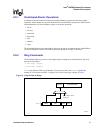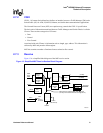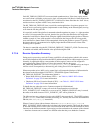
Hardware Reference Manual 59
Intel
®
IXP2800 Network Processor
Technical Description
2.7 Media and Switch Fabric Interface
The Media and Switch Fabric (MSF) Interface is used to connect the IXP2800 Network Processor
to a physical layer device (PHY) and/or to a Switch Fabric. the MSF consists of separate receive
and transmit interfaces. Each of the receive and transmit interfaces can be separately configured for
either SPI-4 Phase 2 (System Packet Interface) for PHY devices or CSIX-L1 protocol for Switch
Fabric Interfaces.
The receive and transmit ports are unidirectional and independent of each other. Each port has 16
data signals, a clock, a control signal, and a parity signal, all of which use LVDS (differential)
signaling, and are sampled on both edges of the clock. There is also a flow control port consisting
of a clock, data, and ready status bits, and used to communicate between two IXP2800 Network
Processors, or the IXP2800 Network Processor chip and a Switch Fabric Interface. These are also
LVDS, dual-edge data transfer. All of the high speed LVDS interfaces support dynamic deskew
training.
The block diagram in Figure 10 shows a typical configuration.
Figure 10. Example System Block Diagram
A9356-03
Ingress
Intel
®
IXP2800
Network Processor
Framing/MAC
Device
(PHY)
SPI-4
Protocol
RDAT
Receive protocol is SPI-4
Transmit mode is CSIX
TDAT
Egress
Intel
®
IXP2800
Network Processor
TSTAT
Flow Control
Receive protocol is CSIX
Transmit mode is SPI-4
RDAT
Optional
Gasket
(Note
1
)
Switch
Fabric
CSIX
Protocol
RSTAT
TDAT
Notes:
1. Gasket is used to convert 16-bit, dual-data IXP2800 signals to wider single edge CWord signals
used by Switch Fabric, if required.
2. Per the CSIX specification, the terms "egress" and ingress" are with respect to the Switch Fabric.
So the egress processor handles traffic received from the Switch Fabric and the ingress
processor handles traffic sent to the Switch Fabric.


















